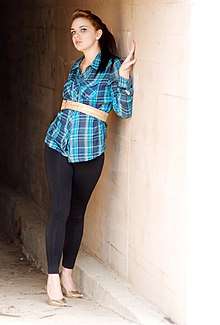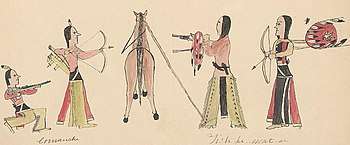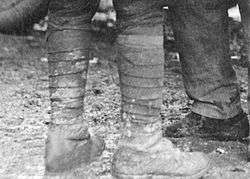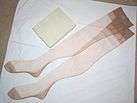Leggings
Leggings refer to several types of leg coverings. Modern usage from the 1960s has come to refer to elastic close-fitting garments worn over the legs typically by women, such as leg warmers or tights. Usage from the 18th century refers to men's wear, usually made of cloth or leather that is wrapped around the leg down to the ankle.[1] In the 19th century, leggings usually referred to infants' leg clothing that were matched with a jacket, as well as leg-wrappings made of leather or wool and worn by soldiers and trappers.[2] Leggings prominently returned to women's fashion in the 1960s, drawing from the form-fitting clothing of dancers. With the widespread adoption of the synthetic fibre Lycra and the rise in popularity of aerobics, leggings came to further prominence in the 1970s and '80s, and eventually made their way into streetwear.[3] Leggings are a part of the late 2010s athleisure fashion trend of wearing activewear outside sporting activities and in casual settings,[4] which became a contentious social norm in the United States.[5]

History

Leggings in various forms and under various names have been worn for warmth and protection by both men and women throughout the centuries. The separate hose worn by men in Europe from the 13th to 16th centuries (the Renaissance period) were a form of leggings, as are the trews of the Scottish Highlands. Separate leggings of buckskin leather were worn by some Native Americans. These were adopted by some Long Hunters, French fur trappers, and later by mountain men. They are the leatherstockings of James Fenimore Cooper's Leatherstocking Tales. The Buckskins were mostly a dull grey brain-tan, not the bright, glossy vegetable tanned leather commonly used today.
Cowboys wore leggings of buckskin to protect from chapping caused by riding, wear and tear to their pants, and bites from animals, such as snakes or insects in the scrub, such as ticks.
In many places, especially in colder countries such as Russia and Korea, men and women continued to wear wool leggings into modern times, often as an additional outer layer for warmth.
The linen pantalettes worn by girls and women under crinolines in the mid-19th century were also a form of leggings, and were originally two separate garments. Leggings became a part of fashion in the 1960s, as trousers similar to capri pants but tighter.
Military use

Since the late 19th century, soldiers of various nations, especially infantry, often wore leggings to protect their lower leg, to keep dirt, sand, and mud from entering their shoes, and to provide a measure of ankle support. At first, these were usually puttees—strips of thick woolen cloth resembling a large bandage—which were wrapped around the leg to support the ankle. They were usually held in place by a strap attached to the cloth. Later, puttees were replaced by some armies with canvas leggings fastened with buckles or buttons, usually secured at the bottom with an adjustable stirrup that passed under the sole of the shoe, just in front of the heel. The soldier placed the leggings around his calf with the buttoned side facing out and adjusted them and the strap to achieve a proper fit. Leggings typically extended to mid-calf and had a garter strap to hold them up and were secured with a tie just below the knee. Military leggings extended to the bottom of the knee and buttoned to the bottom button on the knee-breeches. They are sometimes confused with gaiters, which extend to the high ankle and are worn with full leg trousers.
During World War II, United States Army foot soldiers were referred to as legs by paratroopers and other U.S. forces that did not wear the standard Army leggings issued with the field service shoe. Late in World War II, after experiments with general issue of high-top combat boots and jump boots for soldiers, leggings began to disappear from military service. In 1943, the United States Army modified their field service shoe by adding a taller leather upper that reached to the lower calf; secured by a combination of laces and buckles, the new design was designated the Type III Field Boot. However, the United States Marine Corps retained canvas leggings throughout the war, and used them in combat as late as the Korean War; Marines were referred to as Yellow Leg troops by North Korean and Chinese Communist forces.[6]
By the 1960s, the old style of field shoe had given way to combat boots in most military forces, and leggings of any kind were obsolete. Leggings, usually bright white and often made of patent leather or buff are now worn primarily for ceremonial purposes.
Modern fashion

Leggings in the form of skin-tight trousers, a tighter version of the capris ending at mid-calf or near ankle length, made their way into women's fashion in the 1960s, and were worn with a large belt or waistband and slip-on high heels or ballet flat–styled shoes.
Leggings made from a nylon-lycra blend (usually 90% nylon, 10% lycra) have long been worn during exercise. Nylon lycra leggings are often referred to as bicycle or running tights, and are shinier in appearance than those made from cotton. Some have racing stripes or reflective patterns to further distinguish them as athletic wear and provide extra safety. However, since the 1980s exercise-style leggings have also been worn for fashion and as street wear.[7]
Leggings made from cotton-lycra, or a cotton-polyester-lycra combination, are more typically worn for fashion, but are also worn as exercise wear. Cotton-lycra leggings are available in many colors, prints and designs; but black, navy and various shades of gray remain the most commonly worn.
Wearing black leggings under long, often diaphanous, skirts was part of a general fashion trend of wearing gym or dance clothes as street wear that evolved along with the fitness craze and under the influence of the movie Flashdance and the long-running Broadway show A Chorus Line. A more recent trend has been the wearing of black leggings with miniskirts.
By the early-1990s, leggings were actually outselling jeans in many parts of the United States. It was very common to see leggings worn with long oversized tee-shirts, oversized sweatshirts or oversized sweaters, slouch socks and Keds by girls from toddler to over college age. Fashion turned against leggings for a short time in the late 1990s and early 2000s.
In 2005, leggings made a "comeback" into fashion, particularly in indie culture, with capri-length leggings being worn with mini skirts and dresses. Consequently, leggings are also now popular to wear with oversized, long sweaters, denim mini skirts, plaid skirts, short dresses and short shorts. Leggings are also worn under athletic shorts i.e. Nike Tempo shorts especially in colder weather. Leggings also come in capri length and bike short length. The bike short length is popular under sports uniform shorts and under skirts and dresses as a fashionable item and to keep from showing too much.
For men
At the Marni Men's show during the Fall 2007 Fashion Week, outfits with leggings designed solely for men were introduced.[8]
Men's leggings, dubbed "meggings" (a portmanteau of the words "men" and "leggings") were presented as the latest fashion trend for men at spring/summer 2011 fashion runways, supposed to be styled and layered beneath shorts and preferably with large, baggy, loose or long tops such as T-shirts.[9]
K-pop idols have been wearing male leggings under shorts as a fashion item since the 2010s.[10]
Shiny leggings

Shiny leggings, sometimes called leather-look leggings, have a shiny, metallic (lamé), or wet-like appearance. They emerged as a popular fashion trend in the late-2000s (decade), particularly in 2008 as reported by Stylesignal and other trend forecasters. These leggings are most often a blend of nylon and spandex and come in a variety of colors, although most commonly in black, silver, or gold. These types of leggings are notable for their leather, or even latex appearance and are most often worn as evening or clubwear.
Shiny leggings were featured on fashion runways by many leading designers and were further popularized by celebrities such as Lauren Conrad, Kelly Clarkson and Mary-Kate and Ashley Olsen. Popular makers of shiny leggings include Members Only and American Apparel.
Jeggings
"Jeggings", a registered brand name of Sanko Group,[11] are leggings made to look like skin-tight denim jeans.[12] Jeggings were brought on by the resurgence in style of skinny jeans in the late 2000s, when a higher demand for an even tighter style of pants came about.[13] In 2011 "Jeggings" was entered into the twelfth edition of Concise Oxford English Dictionary.[14]
In sports
Leggings are sometimes worn during sports and other vigorous activities. Runners, dancers, and exercisers may wear them alone or with athletic shorts over them—particularly in cold weather under a sports uniform, e.g. in soccer, with soccer shorts, shin guards and soccer socks over the leggings, or under a cheerleading uniform with socks over the leggings. Leggings have even been worn by a hurling full back.[15]
In school uniforms
Leggings have become a part of many school uniforms. Many schools that have uniform requirements allow leggings as an option in cooler and colder weather as long as the required skirt or dress and required socks are worn over them.
Use as outerwear
There has been societal debate about whether leggings are clothing on their own, which can be worn without covering, or are an accessory only to be worn with other items covering them, such as skirts, dresses or shorts. In a 2016 poll of its readers Glamour magazine said that 61% of its readers thought that leggings should only be worn as an accessory,[16] whereas an article that same year from Good Housekeeping concluded that "...Leggings do, in fact, count as pants—provided they are opaque enough that they don't show your underwear."[17]
There have been a number of instances of people wearing leggings as pants who have been restricted or criticized for their actions. In 2013, schools in Sonoma County, California banned students from wearing them as outerwear,[18] as did a Massachusetts school in 2015.[19] Schools in Oklahoma, Illinois,[20] and North Carolina have enforced or suggested similar dress codes.[21] A state legislator in Montana introduced a bill in 2015 intended to ban leggings and yoga pants.[20]
In March 2017, three children flying on a company pass were barred from boarding a United Airlines flight by a gate agent who decided that their leggings were inappropriate. United Airlines defended its position, while rival airline Delta stated via Twitter that leggings were welcome on its flights; United said in a statement that it does not bar regular female passengers from boarding if they are wearing leggings.[22][23] Although some public figures, including actress Patricia Arquette and model and actress Chrissy Teigen, were critical of United's decision, a survey encompassing 1,800 travelers carried out by Airfarewatchdog found that 80% of their respondents backed the airline's decision to ban "inappropriate clothing", although the term was not defined in the poll.[24]
Restrictions on wearing leggings is sometimes linked to slut shaming or body shaming, with critics noting that "...not being able to wear leggings because it's 'too distracting for boys' is giving us the impression we should be guilty for what guys do."[25]
Gallery
.jpg) A model wearing fully exposed leggings
A model wearing fully exposed leggings.jpg) A runner in leggings
A runner in leggings A man in leggings
A man in leggings A beach volleyball player in leggings
A beach volleyball player in leggings A woman in blue leggings sitting in a library
A woman in blue leggings sitting in a library U.S. Navy ceremonial guard wearing white canvas leggings as part of the U.S. Navy's enlisted full dress whites.
U.S. Navy ceremonial guard wearing white canvas leggings as part of the U.S. Navy's enlisted full dress whites.
See also
References
- Valerie Cumming (2010), "Leggings", The Dictionary of Fashion History, Berg, ISBN 9781847887382
- Mary Brooks Picken (2013), "Leggings", A Dictionary of Costume and Fashion: Historic and Modern, Courier Corporation, ISBN 9780486141602
- Kaori O'Connor (2011), "Lycra, Aerobics, and the Rise of the Legging", Lycra: How A Fiber Shaped America, Routledge, pp. 121–146, 127
- "The 'Athleisure' Trend", Words We're Watching, Merriam-Webster, 2015, retrieved April 12, 2017
- Anne VanderMey (March 27, 2017), "Leggings Should Be Worn On Planes, and the Office, and Everywhere Else", Fortune, retrieved April 12, 2017
- Keene, R. R. (June 1991). "Fix Bayonets: On to the Punchbowl" (PDF). Leatherneck Magazine: 28. Archived from the original (PDF) on 2010-07-14.
- Ex Playboy Model wears Leggings for Streetwear Brand Urbanworld, Urbanworld.eu, 2018, retrieved January 5, 2020
- Fashion Wire Daily (January 22, 2007). "Marni: Leggings are the new must-have". China Daily. Retrieved 13 October 2010.
- Staff (January 3, 2013). "Horrible Leggings For Men Make Way Into Men's Fashion World". Electro WOW ► Electronic Music News. Retrieved 19 October 2014.
- Staff (July 31, 2015). "Trend Alert: Shorts over Leggings for Male Idols". Allkpop. Retrieved 2015-04-16.
- "Welsh designer wins 'veggings' trademark dispute", Drapers, September 5, 2016, retrieved April 12, 2017
- "'Jeggings' to take pants fashion by storm". Oneindia.in. Asian News International. 6 March 2010. Retrieved 28 October 2012.
- "How to Wear Jeggings". StyleTips101.com. June 2010. Retrieved 28 October 2012.
- Lawless, Jill (19 August 2011). "'Retweet,' 'sexting,' 'jeggings' enter Oxford dictionary". The Seattle Times. Associated Press. Retrieved April 12, 2017.
- Staff (December 1, 2013). "Snapshot: Hurling breaks new ground as full-back wears leggings: What next, snoods?". The Score. Archived from the original on 3 December 2013. Retrieved 1 December 2013.
- Clinton, Leah Melby (March 22, 2016) "We Asked, You Answered: Should Leggings Be Worn as Pants?" Glamour.
- Escobar, Sam (October 13, 2016) "Are Leggings Pants? The Case for Both Sides". Good Housekeeping.
- Callahan, Mary (April 11, 2013) "Petaluma, other schools crack down on girls' leggings worn as pants" The Press Democrat
- Khoo, Isabelle (September 1, 2015) "School 'Bans' Yoga Pants and Leggings, But Not for the Reason You Think". Huffington Post.
- Culp-Ressler, Tara (February 11, 2015) "Proposed Bill Has Everyone Confused About Whether You Can Arrest People For Wearing Yoga Pants" ThinkProgress
- Associated Press (May 25, 2016) "North Carolina school looks to ban skinny jeans, leggings" New York Post
- Stack, Liam (March 26, 2017) "After Barring Girls for Leggings, United Airlines Defends Decision" The New York Times
- Zorthian, Julia (March 27, 2017) "Delta Encourages Fliers to Travel in 'Comfort' Amid United’s Leggings Ban Controversy" Fortune
- Paul, Kari (April 8, 2017) "Most travelers say people wearing ‘inappropriate’ clothes shouldn’t be allowed to fly" MarketWatch
- Dockterman, Eliana (March 25, 2014) "When Enforcing School Dress Codes Turns Into Slut Shaming" Time
External links

